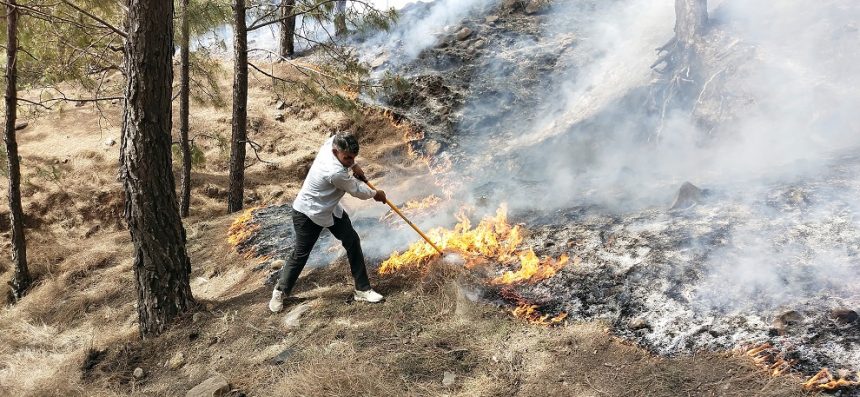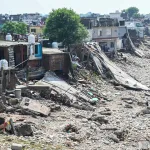Srinagar, Apr 08: Jammu and Kashmir is grappling with a sharp rise in forest fires, with over two dozen incidents reported in recent days, particularly in the southern parts of the region. Experts attribute the surge in fires to an extended dry spell coupled with gusty winds across Kashmir, which have created ideal conditions for the blazes.
The fires have spread across several areas, including Srinagar, Baramulla, Anantnag, Ganderbal, Kupwara, and Kulgam. In the past week alone, more than 20 forest fires were reported in South Kashmir, of which 18 have been contained. However, efforts are still underway to control the remaining outbreaks.
The most significant fires have erupted in areas such as Tral, Pinglish, Dadoo Marhama in Anantnag, Dachnipora in Pahalgam, and Khuwripora in Aishmuqam, Seer Hamdan, and Andoo-Shangus in the Anantnag district. While wildfires are a seasonal occurrence in the sub-tropical forests of the Jammu region, the frequency and intensity of these fires in the Kashmir Valley are unusual.
Environmental experts suggest that shifting climate patterns, reduced winter precipitation, and prolonged dry spells in both autumn and spring are contributing to the increased number of fires. “This is an environmental crisis,” warned Suresh Kumar Gupta, Principal Chief Conservator of Forests and Head of Forest Force (HoFF). “If the dry spell continues, we could witness an unprecedented wildfire season. The fires are destroying our green cover, exacerbating air pollution, and leading to soil erosion.”
Gupta also noted that firefighting teams are on high alert and have been mobilized across the most vulnerable areas. The Forest Department has ramped up surveillance efforts and is working in close coordination with local disaster response units. He urged the public to remain vigilant, report any fire sightings immediately, and avoid reckless behaviors such as burning dry grass or discarding cigarette butts in forested areas.
Arshdeep Singh, Conservator of Forests (South Circle), confirmed that Anantnag and Pulwama have been the hardest-hit districts in South Kashmir. He pointed out that human negligence, especially during recent festivals and forest visits, has played a significant role in igniting these blazes. “Fighting forest fires is not like tackling house fires,” Singh explained. “These fires spread across vast terrains and are aggravated by dryness, temperature, and wind.”
Singh also highlighted the use of traditional firefighting techniques, such as creating fire lines and breaks, alongside modern satellite alerts from the Forest Survey of India, which help track new outbreaks every six hours.
Dr. Mustafa Khan, an environmental expert, called for proactive forest management, including controlled burns and the removal of combustible materials. “Community awareness campaigns, combined with coordination between local communities, government agencies, and NGOs, are crucial for a robust forest fire prevention strategy,” he said.
The absence of snow during this winter has left the forest floors exceptionally dry, making them prone to ignition. Dr. Irfan Rashid, Senior Assistant Professor at the Department of Geoinformatics at the University of Kashmir, noted that the lack of snow cover, which typically acts as a natural moisture reservoir, has exacerbated the problem. “This trend is a clear indication of climate variability,” he said. “It is directly linked to the surge in forest fires we’re witnessing now. Real-time monitoring using satellite data and ground-based sensors is necessary to detect early fire signals and manage them more effectively.”
Dr. Shazia Mir, a climate change researcher and ecologist, warned that without structural changes, the frequency and severity of forest fires will only worsen in the coming years. “We are witnessing the compounded effects of climate change, including warmer temperatures, erratic precipitation, and longer dry periods,” she said. “There is an urgent need to integrate forest fire risk into regional climate adaptation plans. This includes creating fire-resilient landscapes, training community forest guards, and investing in climate-resilient afforestation strategies.”
Dr. Mir also advocated for regional cooperation on data-sharing, fire-mapping, and cross-border early warning systems to tackle forest fires comprehensively across the Himalayan region.
Jammu and Kashmir has a forest cover of 20,230 square kilometers, accounting for roughly 19.95% of its total geographical area. This includes 2,551 square kilometers of reserved forests, 17,643 square kilometers of protected forests, and 36 square kilometers of unclassified forests. According to the India State of Forest Report 2023, Jammu and Kashmir boasts the highest growing stock among all states and union territories at 296.22 cubic meters per hectare. The region also leads in carbon stock among union territories, with 174.10 tons per hectare. The union territory has managed to increase its forest cover by 34.78 square kilometers.
Unprecedented forest fires in Kashmir valley trigger alarm bells
• Dept on high alert; surveillance, firefighting efforts ramped up: Officials • Absence of snowfall, shifting weather patterns made Kashmir forests highly flammable: Experts

Leave a Comment Leave a Comment







